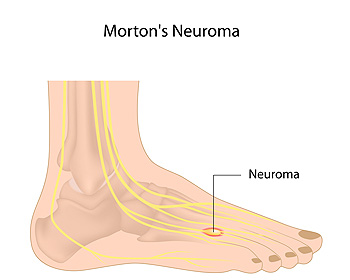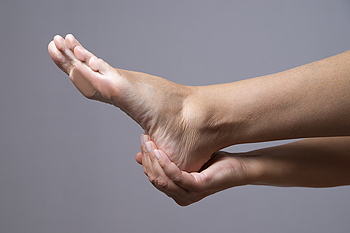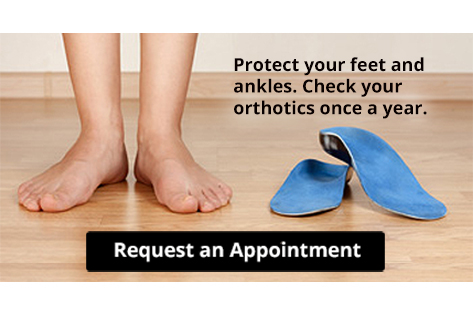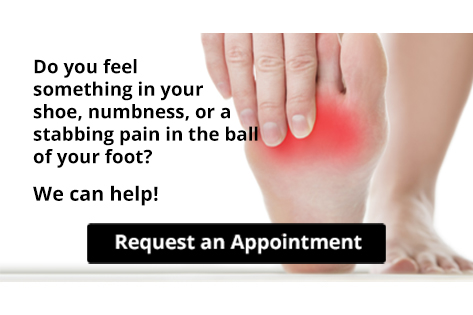Blog
Itchy Feet May Indicate Athlete’s Foot
 The symptoms of a condition that is referred to as athlete’s foot may include mild to severe itching between the toes. Additionally, flaking skin may be present on other parts of the foot, and in some cases, small blisters may appear in the affected area. It is known to be caused by a fungus, which is generally contagious and may also reoccur if it is not treated promptly and correctly. Athletes foot is a result of an infection that is derived from the tinea fungus and will generally live and thrive in warm and moist areas. These may include public shower floors, in addition to pools and surrounding areas. The fungus enters the body through small cracks in the skin, and it may be beneficial to practice good foot hygiene, which may allow these tiny cracks to be noticed. If your feet are itchy and you think you may have this uncomfortable condition, it’s suggested to speak with a podiatrist who can advise you on proper treatment techniques.
The symptoms of a condition that is referred to as athlete’s foot may include mild to severe itching between the toes. Additionally, flaking skin may be present on other parts of the foot, and in some cases, small blisters may appear in the affected area. It is known to be caused by a fungus, which is generally contagious and may also reoccur if it is not treated promptly and correctly. Athletes foot is a result of an infection that is derived from the tinea fungus and will generally live and thrive in warm and moist areas. These may include public shower floors, in addition to pools and surrounding areas. The fungus enters the body through small cracks in the skin, and it may be beneficial to practice good foot hygiene, which may allow these tiny cracks to be noticed. If your feet are itchy and you think you may have this uncomfortable condition, it’s suggested to speak with a podiatrist who can advise you on proper treatment techniques.
Athlete’s foot is an inconvenient condition that can be easily reduced with the proper treatment. If you have any concerns about your feet and ankles, contact Shaun J. Limon, DPM and Lisa Griffith-Limon, DPM from Limons Foot & Ankle Care. Our doctors will treat your foot and ankle needs.
Athlete’s Foot: The Sole Story
Athlete's foot, also known as tinea pedis, can be an extremely contagious foot infection. It is commonly contracted in public changing areas and bathrooms, dormitory style living quarters, around locker rooms and public swimming pools, or anywhere your feet often come into contact with other people.
Solutions to Combat Athlete’s Foot
- Hydrate your feet by using lotion
- Exfoliate
- Buff off nails
- Use of anti-fungal products
- Examine your feet and visit your doctor if any suspicious blisters or cuts develop
Athlete’s foot can cause many irritating symptoms such as dry and flaking skin, itching, and redness. Some more severe symptoms can include bleeding and cracked skin, intense itching and burning, and even pain when walking. In the worst cases, Athlete’s foot can cause blistering as well. Speak to your podiatrist for a better understanding of the different causes of Athlete’s foot, as well as help in determining which treatment options are best for you.
If you have any questions please feel free to contact our offices located in Bradenton and Lakewood Ranch, FL . We offer the newest diagnostic and treatment technologies for all your foot and ankle needs.
Read more about Athlete's FootIt's Time for Beautiful Feet
Causes of Heel Spurs
 If you have a heel spur, you are most likely familiar with the pain and discomfort this condition may cause. The small, bony protrusion that forms on the heel may be a result of repetitive stress the heel endures, possibly originating from frequent running or jumping. Additionally, if the incorrect shoes are worn, or an abnormal walking pattern exists, a heel spur may begin to develop. Some patients may notice pain in the heel and surrounding area while walking, and it may be quite uncomfortable in the morning when the first steps are taken. There may be measures that can be taken, which may possibly prevent heel spurs from forming. These may include wearing shoes that properly support your feet, performing gentle foot stretches before physical activity begins, and maintaining a healthy weight, which may lessen the amount of pressure the heel may endure. If you have heel pain, it is suggested to speak with a podiatrist who can determine if you have a heel spur and can advise on proper treatment techniques.
If you have a heel spur, you are most likely familiar with the pain and discomfort this condition may cause. The small, bony protrusion that forms on the heel may be a result of repetitive stress the heel endures, possibly originating from frequent running or jumping. Additionally, if the incorrect shoes are worn, or an abnormal walking pattern exists, a heel spur may begin to develop. Some patients may notice pain in the heel and surrounding area while walking, and it may be quite uncomfortable in the morning when the first steps are taken. There may be measures that can be taken, which may possibly prevent heel spurs from forming. These may include wearing shoes that properly support your feet, performing gentle foot stretches before physical activity begins, and maintaining a healthy weight, which may lessen the amount of pressure the heel may endure. If you have heel pain, it is suggested to speak with a podiatrist who can determine if you have a heel spur and can advise on proper treatment techniques.
Heel spurs can be incredibly painful and sometimes may make you unable to participate in physical activities. To get medical care for your heel spurs, contact Shaun J. Limon, DPM and Lisa Griffith-Limon, DPM from Limons Foot & Ankle Care. Our doctors will do everything possible to treat your condition.
Heels Spurs
Heel spurs are formed by calcium deposits on the back of the foot where the heel is. This can also be caused by small fragments of bone breaking off one section of the foot, attaching onto the back of the foot. Heel spurs can also be bone growth on the back of the foot and may grow in the direction of the arch of the foot.
Older individuals usually suffer from heel spurs and pain sometimes intensifies with age. One of the main condition's spurs are related to is plantar fasciitis.
Pain
The pain associated with spurs is often because of weight placed on the feet. When someone is walking, their entire weight is concentrated on the feet. Bone spurs then have the tendency to affect other bones and tissues around the foot. As the pain continues, the feet will become tender and sensitive over time.
Treatments
There are many ways to treat heel spurs. If one is suffering from heel spurs in conjunction with pain, there are several methods for healing. Medication, surgery, and herbal care are some options.
If you have any questions feel free to contact our offices located in Bradenton and Lakewood Ranch, FL . We offer the latest in diagnostic and treatment technology to meet your needs.
Read more about Heel SpursExercising in Bare Feet May Be Beneficial
 Research has shown that it may be beneficial for the feet and body to exercise bare foot. Professors at the department of Exercise and Sports Sciences at Ithaca College have stated that messages are received in the brain from the feet relating to the environment. When shoes are worn, these messages may get confused as a result of the feet not making direct contact with the ground. The outcome may be overcompensation of other muscle groups, which may ultimately lead to injury. The importance of increasing the strength of small foot muscles may lead to the development of large foot muscles and may decrease the risk of a potential injury. If you would like additional information about the benefits of exercising in bare feet, please speak with a podiatrist.
Research has shown that it may be beneficial for the feet and body to exercise bare foot. Professors at the department of Exercise and Sports Sciences at Ithaca College have stated that messages are received in the brain from the feet relating to the environment. When shoes are worn, these messages may get confused as a result of the feet not making direct contact with the ground. The outcome may be overcompensation of other muscle groups, which may ultimately lead to injury. The importance of increasing the strength of small foot muscles may lead to the development of large foot muscles and may decrease the risk of a potential injury. If you would like additional information about the benefits of exercising in bare feet, please speak with a podiatrist.
Exercising your feet regularly with the proper foot wear is a great way to prevent injuries and build strength. If you have any concerns about your feet, contact Shaun J. Limon, DPM and Lisa Griffith-Limon, DPM from Limons Foot & Ankle Care. Our doctors can provide the care you need to keep you pain-free and on your feet.
Exercise for Your Feet
Exercise for your feet can help you gain strength, mobility and flexibility in your feet. They say that strengthening your feet can be just as rewarding as strengthening another part of the body. Your feet are very important, and we often forget about them in our daily tasks. But it is because of our feet that are we able to get going and do what we need to. For those of us fortunate enough to not have any foot problems, it is an important gesture to take care of them to ensure good health in the long run.
Some foot health exercises can include ankle pumps, tip-toeing, toe rises, lifting off the floor doing reps and sets, and flexing the toes. It is best to speak with Our doctors to determine an appropriate regimen for your needs. Everyone’s needs and bodies are different, and the activities required to maintain strength in the feet vary from individual to individual.
Once you get into a routine of doing regular exercise, you may notice a difference in your feet and how strong they may become.
If you have any questions please feel free to contact our offices located in Bradenton and Lakewood Ranch, FL . We offer the newest diagnostic and treatment technologies for all your foot and ankle needs.
Read more about Exercise for Your FeetHeel Pain Can Be Treated!
Hammertoe May Be Preceded by a Bunion
 If you notice a sizable bump on the second toe of your foot, you may have what can develop into a hammertoe. Many people experience a bunion first, and this will typically occur on the side of the big toe. As this condition develops, the toes push against each other causing the middle toe to bend downward, and this may cause pain and discomfort. Research has shown this condition may be more apt to develop in people who are experiencing arthritis in the bones of the feet. There may be preventive measures to halt this ailment from happening, including wearing shoes that have adequate room for the toes to move about it in. Moderate relief may be found by performing specific exercises that can stretch the toes. One example would be to try soaking the feet in warm water daily, followed by pointing the toes. This may benefit in stretching the tendons of the toe. If you feel you are developing this condition, please consult with a podiatrist for treatment options that are correct for you.
If you notice a sizable bump on the second toe of your foot, you may have what can develop into a hammertoe. Many people experience a bunion first, and this will typically occur on the side of the big toe. As this condition develops, the toes push against each other causing the middle toe to bend downward, and this may cause pain and discomfort. Research has shown this condition may be more apt to develop in people who are experiencing arthritis in the bones of the feet. There may be preventive measures to halt this ailment from happening, including wearing shoes that have adequate room for the toes to move about it in. Moderate relief may be found by performing specific exercises that can stretch the toes. One example would be to try soaking the feet in warm water daily, followed by pointing the toes. This may benefit in stretching the tendons of the toe. If you feel you are developing this condition, please consult with a podiatrist for treatment options that are correct for you.
Hammertoe
Hammertoes can be a painful condition to live with. For more information, contact Shaun J. Limon, DPM and Lisa Griffith-Limon, DPM from Limons Foot & Ankle Care. Our doctors will answer any of your foot- and ankle-related questions.
Hammertoe is a foot deformity that affects the joints of the second, third, fourth, or fifth toes of your feet. It is a painful foot condition in which these toes curl and arch up, which can often lead to pain when wearing footwear.
Symptoms
- Pain in the affected toes
- Development of corns or calluses due to friction
- Inflammation
- Redness
- Contracture of the toes
Causes
Genetics – People who are genetically predisposed to hammertoe are often more susceptible
Arthritis – Because arthritis affects the joints in your toes, further deformities stemming from arthritis can occur
Trauma – Direct trauma to the toes could potentially lead to hammertoe
Ill-fitting shoes – Undue pressure on the front of the toes from ill-fitting shoes can potentially lead to the development of hammertoe
Treatment
Orthotics – Custom made inserts can be used to help relieve pressure placed on the toes and therefore relieve some of the pain associated with it
Medications – Oral medications such as anti-inflammatories or NSAIDs could be used to treat the pain and inflammation hammertoes causes. Injections of corticosteroids are also sometimes used
Surgery – In more severe cases where the hammertoes have become more rigid, foot surgery is a potential option
If you have any questions please contact our offices located in Bradenton and Lakewood Ranch, FL . We offer the newest diagnostic and treatment technologies for all your foot and ankle needs.
Read more about HammertoeSymptoms of Morton’s Neuroma
 If you experience pain and discomfort between the third and fourth toes, you may have a condition that is referred to as Morton’s neuroma. The pain originates from tissue that has been affected as a result of a swollen nerve on the bottom of the foot. Research has shown that being involved in specific sports or wearing high heels may play a significant role in the development of this uncomfortable condition. Patients often notice a burning sensation in the ball of the foot. This may intensify as weight is put on the foot, in addition to a numbness or tingling feeling. Relief may be obtained by wearing correct footwear or gently massaging the affected area. If you feel you may have Morton’s neuroma, it’s advised to seek the counsel of a podiatrist who can properly inform you of correct treatment techniques.
If you experience pain and discomfort between the third and fourth toes, you may have a condition that is referred to as Morton’s neuroma. The pain originates from tissue that has been affected as a result of a swollen nerve on the bottom of the foot. Research has shown that being involved in specific sports or wearing high heels may play a significant role in the development of this uncomfortable condition. Patients often notice a burning sensation in the ball of the foot. This may intensify as weight is put on the foot, in addition to a numbness or tingling feeling. Relief may be obtained by wearing correct footwear or gently massaging the affected area. If you feel you may have Morton’s neuroma, it’s advised to seek the counsel of a podiatrist who can properly inform you of correct treatment techniques.
Morton’s neuroma is a very uncomfortable condition to live with. If you think you have Morton’s neuroma, contact Shaun J. Limon, DPM and Lisa Griffith-Limon, DPM of Limons Foot & Ankle Care. Our doctors will attend to all of your foot care needs and answer any of your related questions.
Morton’s Neuroma
Morton's neuroma is a painful foot condition that commonly affects the areas between the second and third or third and fourth toe, although other areas of the foot are also susceptible. Morton’s neuroma is caused by an inflamed nerve in the foot that is being squeezed and aggravated by surrounding bones.
What Increases the Chances of Having Morton’s Neuroma?
- Ill-fitting high heels or shoes that add pressure to the toe or foot
- Jogging, running or any sport that involves constant impact to the foot
- Flat feet, bunions, and any other foot deformities
Morton’s neuroma is a very treatable condition. Orthotics and shoe inserts can often be used to alleviate the pain on the forefront of the feet. In more severe cases, corticosteroids can also be prescribed. In order to figure out the best treatment for your neuroma, it’s recommended to seek the care of a podiatrist who can diagnose your condition and provide different treatment options.
If you have any questions, please feel free to contact our offices located in Bradenton and Lakewood Ranch, FL . We offer the newest diagnostic and treatment technologies for all your foot care needs.
Read more about Morton's NeuromaReminder: When Was the Last Time...?
The Differences Between a Sprained Toe and a Broken Toe
 Many people mistake a stubbed toe with a broken toe. This may be a common error because they both produce considerable pain and discomfort. If a toe is broken, it’s important to obtain proper treatment as quickly as possible. If the toe is left untreated, it may affect walking and running ability in addition to experiencing chronic pain. There is known to be a few differences between a broken toe and a sprained toe. These may include bruising, pain in the exact area of the break, or a possible dislocation, which may accompany a fractured toe. A sprained toe may have more generalized pain in the surrounding area where the injury has occurred, although there may be considerable bruising. If you feel you have broken or sprained your toe, it may be beneficial to seek the counsel of a podiatrist to obtain a correct diagnosis and offer the best course of treatment.
Many people mistake a stubbed toe with a broken toe. This may be a common error because they both produce considerable pain and discomfort. If a toe is broken, it’s important to obtain proper treatment as quickly as possible. If the toe is left untreated, it may affect walking and running ability in addition to experiencing chronic pain. There is known to be a few differences between a broken toe and a sprained toe. These may include bruising, pain in the exact area of the break, or a possible dislocation, which may accompany a fractured toe. A sprained toe may have more generalized pain in the surrounding area where the injury has occurred, although there may be considerable bruising. If you feel you have broken or sprained your toe, it may be beneficial to seek the counsel of a podiatrist to obtain a correct diagnosis and offer the best course of treatment.
A broken toe can be very painful and lead to complications if not properly fixed. If you have any concerns about your feet, contact Shaun J. Limon, DPM and Lisa Griffith-Limon, DPM from Limons Foot & Ankle Care. Our doctors will treat your foot and ankle needs.
What to Know About a Broken Toe
Although most people try to avoid foot trauma such as banging, stubbing, or dropping heavy objects on their feet, the unfortunate fact is that it is a common occurrence. Given the fact that toes are positioned in front of the feet, they typically sustain the brunt of such trauma. When trauma occurs to a toe, the result can be a painful break (fracture).
Symptoms of a Broken Toe
- Throbbing pain
- Swelling
- Bruising on the skin and toenail
- The inability to move the toe
- Toe appears crooked or disfigured
- Tingling or numbness in the toe
Generally, it is best to stay off of the injured toe with the affected foot elevated.
Severe toe fractures may be treated with a splint, cast, and in some cases, minor surgery. Due to its position and the pressure it endures with daily activity, future complications can occur if the big toe is not properly treated.
If you have any questions please feel free to contact our offices located in Bradenton and Lakewood Ranch, FL . We offer the newest diagnostic and treatment technologies for all your foot and ankle needs.
Read more about What to Know About a Broken ToeLifestyle Changes and Gout
 The medical condition referred to as gout is the result of elevated uric acid levels in the blood. The symptoms of this uncomfortable ailment may include severe pain surrounding the big toe, swelling, and redness. Research has shown there may be triggers that may cause gout including ingesting certain medications, a sudden illness, or an injury to the joint in the toe. Additionally, many gout patients may benefit from a healthy lifestyle change, such as eliminating specific foods and drinks from their daily intake. People who consume an excess of alcohol, or eat an abundance of red meat and shellfish may be more likely to develop gout and this may be a cause of inflated uric acid levels. A podiatrist can perform a proper diagnosis, which may include having an X-ray or CAT scan taken. This will enable the soft tissue and bone to be examined. Once this condition is confirmed, the correct treatment can begin.
The medical condition referred to as gout is the result of elevated uric acid levels in the blood. The symptoms of this uncomfortable ailment may include severe pain surrounding the big toe, swelling, and redness. Research has shown there may be triggers that may cause gout including ingesting certain medications, a sudden illness, or an injury to the joint in the toe. Additionally, many gout patients may benefit from a healthy lifestyle change, such as eliminating specific foods and drinks from their daily intake. People who consume an excess of alcohol, or eat an abundance of red meat and shellfish may be more likely to develop gout and this may be a cause of inflated uric acid levels. A podiatrist can perform a proper diagnosis, which may include having an X-ray or CAT scan taken. This will enable the soft tissue and bone to be examined. Once this condition is confirmed, the correct treatment can begin.
Gout is a painful condition that can be treated. If you are seeking treatment, contact Shaun J. Limon, DPM and Lisa Griffith-Limon, DPM from Limons Foot & Ankle Care. Our doctors will treat your foot and ankle needs.
What Is Gout?
Gout is a form of arthritis that is characterized by sudden, severe attacks of pain, redness, and tenderness in the joints. The condition usually affects the joint at the base of the big toe. A gout attack can occur at any random time, such as the middle of the night while you are asleep.
Symptoms
- Intense Joint Pain - Usually around the large joint of your big toe, and it most severe within the first four to twelve hours
- Lingering Discomfort - Joint discomfort may last from a few days to a few weeks
- Inflammation and Redness -Affected joints may become swollen, tender, warm and red
- Limited Range of Motion - May experience a decrease in joint mobility
Risk Factors
- Genetics - If family members have gout, you’re more likely to have it
- Medications - Diuretic medications can raise uric acid levels
- Gender/Age - Gout is more common in men until the age of 60. It is believed that estrogen protects women until that point
- Diet - Eating red meat and shellfish increases your risk
- Alcohol - Having more than two alcoholic drinks per day increases your risk
- Obesity - Obese people are at a higher risk for gout
Prior to visiting your podiatrist to receive treatment for gout, there are a few things you should do beforehand. If you have gout you should write down your symptoms--including when they started and how often you experience them, important medical information you may have, and any questions you may have. Writing down these three things will help your podiatrist in assessing your specific situation so that he or she may provide the best route of treatment for you.
If you have any questions, please feel free to contact our offices located in Bradenton and Lakewood Ranch, FL . We offer the newest diagnostic and treatment technologies for all your foot care needs.
Read more about GoutMore...
Why Live with Pain and Numbness in Your Feet?
There Are Several Causes of Heel Pain
 Many people experience heel pain at some point in their lives. Research has shown the most common type of this uncomfortable condition is referred to as plantar fasciitis. This affects the band of tissue known as the plantar fascia, which connects the heel to the toes. Inflammation may gradually develop as a result of high or low arches or if an injury to the foot has occurred. Bursitis in the heel is another form of foot pain, and may be a result of wearing shoes that do not fit correctly. This type of inflammation originates in the fluid-filled bursa, which is located at the back of the heel. Additionally, a condition known as heel bumps typically affect teenagers. This may be a result of wearing shoes that cause friction on the underdeveloped heel bone. If the Achilles tendon should endure an injury, severe pain is generally felt in the back of the heel and may gravitate to the back of the calf. If you are experiencing heel pain, it’s suggested to speak to a podiatrist who can determine the cause and begin proper treatment as quickly as possible.
Many people experience heel pain at some point in their lives. Research has shown the most common type of this uncomfortable condition is referred to as plantar fasciitis. This affects the band of tissue known as the plantar fascia, which connects the heel to the toes. Inflammation may gradually develop as a result of high or low arches or if an injury to the foot has occurred. Bursitis in the heel is another form of foot pain, and may be a result of wearing shoes that do not fit correctly. This type of inflammation originates in the fluid-filled bursa, which is located at the back of the heel. Additionally, a condition known as heel bumps typically affect teenagers. This may be a result of wearing shoes that cause friction on the underdeveloped heel bone. If the Achilles tendon should endure an injury, severe pain is generally felt in the back of the heel and may gravitate to the back of the calf. If you are experiencing heel pain, it’s suggested to speak to a podiatrist who can determine the cause and begin proper treatment as quickly as possible.
Many people suffer from bouts of heel pain. For more information, contact Shaun J. Limon, DPM and Lisa Griffith-Limon, DPM of Limons Foot & Ankle Care. Our doctors can provide the care you need to keep you pain-free and on your feet.
Causes of Heel Pain
Heel pain is often associated with plantar fasciitis. The plantar fascia is a band of tissues that extends along the bottom of the foot. A rip or tear in this ligament can cause inflammation of the tissue.
Achilles tendonitis is another cause of heel pain. Inflammation of the Achilles tendon will cause pain from fractures and muscle tearing. Lack of flexibility is also another symptom.
Heel spurs are another cause of pain. When the tissues of the plantar fascia undergo a great deal of stress, it can lead to ligament separation from the heel bone, causing heel spurs.
Why Might Heel Pain Occur?
- Wearing ill-fitting shoes
- Wearing non-supportive shoes
- Weight change
- Excessive running
Treatments
Heel pain should be treated as soon as possible for immediate results. Keeping your feet in a stress-free environment will help. If you suffer from Achilles tendonitis or plantar fasciitis, applying ice will reduce the swelling. Stretching before an exercise like running will help the muscles. Using all these tips will help make heel pain a condition of the past.
If you have any questions please contact our offices located in Bradenton and Lakewood Ranch, FL . We offer the newest diagnostic and treatment technologies for all your foot and ankle needs.
Read more about Heel PainCauses for Blisters on the Feet
 The majority of runners realize the negative impact blisters on the feet can have on their chosen sport of running. The small areas appearing on the toes, heel, or bottom of the foot filled with fluid may be susceptible to infection if not treated in a prompt fashion. Research has shown the cause of this condition may be from increased friction and pressure that are inflicted on the toes. There may be several reasons for this to occur including wearing shoes and socks that fit incorrectly or having the skin become too soft as a result of excess moisture,which may typically originate from sweat. It’s important to properly measure your feet for a correct fit, allowing a half size larger than your regular shoe to accommodate the swelling that incurs as running progresses. Additional causes for blisters to develop may be enduring extreme sunburn or frostbite. The body will naturally protect the affected skin by encasing it in a fluid based environment, while healing takes place. If you are afflicted with a blister on your foot, it’s advised to consult with a podiatrist to learn how to properly treat this condition.
The majority of runners realize the negative impact blisters on the feet can have on their chosen sport of running. The small areas appearing on the toes, heel, or bottom of the foot filled with fluid may be susceptible to infection if not treated in a prompt fashion. Research has shown the cause of this condition may be from increased friction and pressure that are inflicted on the toes. There may be several reasons for this to occur including wearing shoes and socks that fit incorrectly or having the skin become too soft as a result of excess moisture,which may typically originate from sweat. It’s important to properly measure your feet for a correct fit, allowing a half size larger than your regular shoe to accommodate the swelling that incurs as running progresses. Additional causes for blisters to develop may be enduring extreme sunburn or frostbite. The body will naturally protect the affected skin by encasing it in a fluid based environment, while healing takes place. If you are afflicted with a blister on your foot, it’s advised to consult with a podiatrist to learn how to properly treat this condition.
Blisters may appear as a single bubble or in a cluster. They can cause a lot of pain and may be filled with pus, blood, or watery serum. If your feet are hurting, contact Shaun J. Limon, DPM and Lisa Griffith-Limon, DPM of Limons Foot & Ankle Care. Our doctors can provide the care you need to keep you pain-free and on your feet.
Foot Blisters
Foot blisters are often the result of friction. This happens due to the constant rubbing from shoes, which can lead to pain.
What Are Foot Blisters?
A foot blister is a small fluid-filled pocket that forms on the upper-most layer of the skin. Blisters are filled with clear fluid and can lead to blood drainage or pus if the area becomes infected.
Symptoms
(Blister symptoms may vary depending on what is causing them)
- Bubble of skin filled with fluid
- Redness
- Moderate to severe pain
- Itching
Prevention & Treatment
In order to prevent blisters, you should be sure to wear comfortable shoes with socks that cushion your feet and absorb sweat. Breaking a blister open may increase your chances of developing an infection. However, if your blister breaks, you should wash the area with soap and water immediately and then apply a bandage to the affected area. If your blisters cause severe pain it is important that you call your podiatrist right away.
If you have any questions, please feel free to contact our offices located in Bradenton and Lakewood Ranch, FL . We offer the newest diagnostic and treatment technologies for all your foot care needs.
Read more about Blisters




